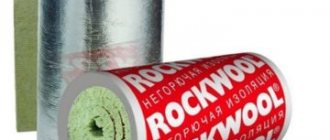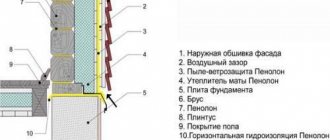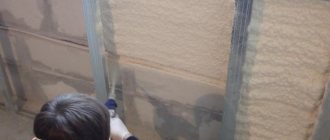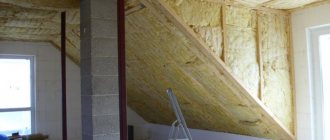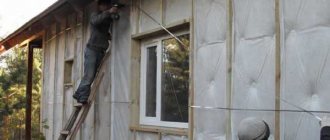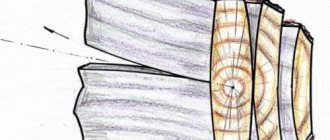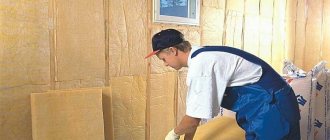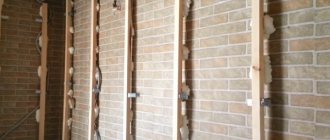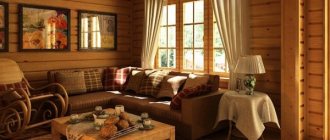To build a comfortable, warm home, it is not enough just to install heating and seal the seams .
With thin walls that do not retain heat well, heating costs will be incredibly high, and the heat in the house will not be retained.
To ensure that warm air does not escape from the room, and that the walls perform not only the function of protection from external influences, but also the function of thermal insulation, it is necessary to insulate them.
The following materials are suitable for insulation:
Insulation of walls inside and outside the house - differences
Wall insulation is carried out both inside and outside .
If it is necessary to insulate walls, then, as a rule, one insulation option is chosen: either from the inside of the load-bearing wall or from the outside.
It is also possible to insulate a wall on both sides, but this is not always necessary : insulation options are chosen based on climatic conditions, construction features, and individual preferences.
Indoor insulation is installed on the inside of the building.
The disadvantages of this option are the following:
- the free space of the room decreases;
- the likelihood of dew point formation inside the wall or between the insulation and the wall.
Internal insulation of the walls of a house is good because:
- weather conditions will not affect the work schedule;
- If the building has cladding, it is possible to preserve it unchanged.
Insulation of external walls is carried out from the outside of the building. With this type of thermal insulation, the usable area of the structure is preserved; there is no need to install a vapor barrier layer . However, if the cladding of the building has already been completed, it must be dismantled.
Reasons for carrying out work from the inside
The only argument in favor of internal insulation is:
- a ban by local authorities on work related to changing the facade of buildings (architectural monuments, buildings on central streets, etc.);
- there is an expansion joint located outside;
- a wall separates the room from an elevator shaft or other technical room where there is no access for installing insulation;
- internal insulation is provided for in the house construction project.
If there are no options to avoid indoor insulation, then it is necessary to take seriously the organization of work, from the selection of thermal insulation composites to installation technology.
Pie wall elements
Before insulating the walls of the house and attic, it is necessary to correctly lay the layers of the cake. Pie walls are sequentially laid layers of materials that serve to ensure a comfortable microclimate in the house.
The elements of the wall pie of a wooden house are:
- wooden frame made of timber . Most often made of beams 15x15 cm;
- horizontal wooden lathing , sometimes a metal profile is used;
- insulation made of mineral wool or expanded polystyrene;
- The membrane is multifunctional , performing the function of protection from winds and at the same time acting as a vapor barrier. It is a dense polyethylene film;
- vertical lathing;
- finishing material;
- vapor barrier film;
- internal cladding (plasterboard, lining).
For all wooden wall elements, it is necessary to use high-quality wood , which must be dried naturally. In addition, materials should be chosen of high quality and durable so that the walls perform their functions for many years.
Types of insulation - which is better?
For proper internal insulation of a wooden house, insulation materials are used that, while maintaining thermal insulation properties, do not cause an unpleasant odor over time, are fireproof and environmentally friendly.
The most common options for internal insulation are:
- mineral basalt wool . It is the most popular material for wall insulation. The features of this material are: good thermal insulation properties, high level of sound insulation, fire resistance, strength, high hygroscopicity, due to which it is necessary to install piping from vapor barrier films;
- foam boards . Because the material can release styrene, extruded polystyrene foam is used, which requires a containment system. The material has good thermal insulation, has soundproofing properties, however, it is quite fragile;
- glass wool It has greater thermal conductivity than mineral wool, but the price of the material is significantly lower than basalt slabs. The material crumbles a lot, so it should be laid in protective equipment: crumbs of material are harmful to health. In addition, it is necessary to install enclosing structures;
- isoplat . Insulation, which consists of compressed flax fibers and wood board. An ideal thermal insulation material from the point of view of environmental friendliness, and also durable enough that it does not require the installation of fencing systems;
- polyurethane foam , which is installed by spraying it onto the surface, is installed using special equipment. Modern and quite expensive material.
Comparative characteristics of thermal insulation
The type of insulation should be chosen based on the characteristics of the building, climatic conditions, and the purpose of the building.
The real state of affairs
The reality is that not in all cases it is possible to carry out work according to the textbook. In some cases, it is impossible to insulate a house from the outside:
- The building is an architectural monument. The façade must be left untouched.
- The upper floors of a brick house in the absence of the ability to work at high heights.
- The distance between the houses is too small, which does not allow work to insulate them from the outside.
Let's consider actions in a situation where insulation from the outside of the building is impossible. How to insulate the walls of a brick house from the inside with your own hands?
The main problem that residents of the house will face is condensation in undesirable places with all that it entails. To protect yourself from this trouble, you need to hermetically insulate the walls with insulation from the rest of the room.
There are two ways to do this task yourself:
- When choosing insulation, you should give preference to a material with very low permeability to water vapor. Common options include penofol and extruded polystyrene foam. The side with the foam foil and the compacted surface of the polystyrene foam should face the inside of the room. Only in this way will it be possible to avoid the absorption of steam by the insulation.
- If mineral or basalt insulation is used, they can be protected using a vapor barrier. However, sealing should be carried out with special care: no possibility of steam contact with the insulation or wall should be left. The film is attached with an overlap, and the seam is taped.
Seal cracks in walls and insulate
In wooden beams dried using the appropriate technology, cracks form that need to be sealed.
Means for sealing cracks are:
- sealants and other synthetic products : resins, mastics, mounting foams. Synthetic sealants should not have an acrylic substance. Silicone seals must have a high level of frost resistance. The mixtures are placed deeply into the gap, and after drying the area is leveled. Polyurethane foam is used in places where facing work will subsequently be carried out;
- wood shavings mixed with wood glue . Used at any stage of finishing, as well as during additional inspection. The prepared mixture is poured into the previously cleaned crack of dust, then, after complete drying, the area is processed by grinding. The method is advisable to use for small cracks;
- decorative mixtures for sealing;
- fibrous materials - caulk (moss, wool, tow). Pre-cleaned cracks, impregnated with antiseptics and solutions that prevent the formation of mold, mildew, and dampness, are clogged with caulk.
Wood requires constant care and timely sealing of cracks that may appear over time. Regular inspection of the wood will help prevent gaps from growing, which can reduce the insulation properties of the walls.
Padding
Applying a layer of primer will reduce the degree of vapor permeability of the walls, strengthen the surface and increase the degree of adhesion to the adhesive composition. In addition, such treatment will prevent the development of fungus.
For priming, deep penetration compounds should be chosen. For wood processing, it is better to choose alkyd mixtures. Acrylic primer is universal and can be used for all types of surfaces. Epoxy compounds are used only for treating concrete and brick walls.
The primer is applied twice. The second layer is applied only after the first has dried. Smooth walls can be primed with a roller. If there are a large number of dents and chips, it is better to use a regular brush, the bristles of which can penetrate even the smallest crevices.
Priming walls with a roller
Preparing the sheathing and installing it
For the sheathing of walls inside a wooden dacha, wooden materials are used. Metal lathing is installed when the wall is covered with moisture-resistant plasterboard.
The installation of sheathing includes a number of preparatory works in the following order:
- apply markings for installation of the sheathing. The width of the sheathing is selected based on the width of the insulation minus 2-5 millimeters . The insulation should stand up against the sheathing;
- preparation of corner posts . Necessary for creating an even wall angle. The height of the beam 50x100 mm should be equal to the height of the room. The smaller beam 50x50 mm is fastened with self-tapping screws to the edge of the larger beam, forming a right angle;
- making corner posts for all corners of the room;
- preparation of vertical boards for sheathing: boards are cut according to the height of the room in quantities corresponding to the pitch, 2 - 5 cm less than the insulation board.
Installation of the sheathing begins from the corners : using self-tapping screws, the corner posts are installed in their places, their vertical position is checked with a level. Next, from the corners to the center, the remaining sheathing boards are attached along the entire perimeter.
The next step is to install strips around the wall openings.
After installing the lathing, a layer of heat-insulating material is laid.
Vapor barrier and waterproofing of walls
When insulating walls internally, it is necessary to install a vapor barrier and waterproofing layer.
Vapor barrier materials can be:
- polypropylene films;
- foamed polymer films;
- foil films;
- diffusion membranes.
The vapor barrier layer is produced taking into account the specifics of its installation:
- The film should be attached to the sheathing using an overlapping stapler, and the joining points should be taped;
- the lathing on which the vapor barrier is attached should be no more than 5 cm;
- The vapor barrier layer is laid using a continuous contour method around the entire perimeter.
A waterproofing layer, which protects against moisture coming from outside, is laid on the wall. Laying nuances:
- the waterproofing film is attached to the sheathing, leaving space for ventilation;
- a profile is attached to the film;
- Insulation is laid between the profile, and then a vapor barrier layer.
Laying a vapor barrier film
Before installing the insulation, a foil material that reflects heat or a thick polyethylene film is fixed to the wall. They are secured to wooden blocks or profiles using staples, tape or mounting adhesive. The foil material is laid on the shiny side
outward to the room.
All joints are taped with construction tape. In places where they adjoin building structures and pipes, they are additionally treated with liquid sealant and secured with a stapler.
Finishing with foil insulation
The film or foil material is laid overlapping, and the joints of the fabric should fall on the frame posts. A small overlap is made on the adjacent walls, windows, ceiling and floor.
Insulation of walls from the inside in a private house using mineral wool
Before insulating the walls from the inside, it is necessary to secure the sheathing.
Mineral wool is a material that has good thermal insulation properties, is easy to install and durable.
It is necessary to lay mineral wool slabs between the sheathing boards in such a way that no gaps are formed.
- mineral wool is secured with nails and dowels (fungi);
- lay the material from bottom to top;
- The edges of the mineral wool are slightly pressed for a tighter fit.
After the insulation is securely fastened, a vapor barrier layer is laid on it.
Disadvantages of internal thermal insulation
This method has its drawbacks, which is why it has many opponents.
Problems with internal thermal insulation of walls arise as follows:
- with external thermal insulation, the walls of the building are protected from the cold, which cannot be achieved with insulation from the inside. The base is in contact with the environment and cracks may appear on it;
- the occurrence of condensation. With internal heat conservation, the dew point moves behind the supporting structure and forms between the insulator and the surface. The result may be the development of fungal formations that will be difficult to notice;
- reduction in area. Modern heat insulators have excellent characteristics, but have not yet come up with a material that would take up little space. At the moment, with insulation work, the room will become 10 cm smaller on each side.
Before making a decision on internal insulation, it is worth weighing all the disadvantages and considering the advantages; this is the only way to avoid errors and shortcomings during installation.
Do-it-yourself insulation of walls from the inside using polystyrene foam
The installation technique with polystyrene foam is quite simple, and if done correctly, it can provide reliable thermal insulation in the house.
Insulation with expanded polystyrene occurs in several stages:
- if the walls are made of round logs, then they need to be trimmed;
- between the lathing slats, panels of material are placed in a tight fit;
- the slabs can be additionally secured with foam blades;
- eliminate possible gaps using polyurethane foam.
Next, a vapor barrier is attached to the sheathing slats.
Precautionary measures
When working with glass fiber you need to be very careful. You need to wear overalls made of fairly dense material. Prevent small pieces of fiberglass from coming into contact with your skin. No exposed skin is allowed. The eyes and respiratory tract also need to be protected. Wear goggles and a respirator.
During operation, the fiberglass breaks and small, sharp glass particles are formed; when they come into contact with the skin, they cause itching. Getting them into the respiratory tract is extremely dangerous. Once fiberglass debris gets on your clothing, it will be nearly impossible to remove.
If contact with glass wool particles does occur, you must do the following:
- Do not scratch areas of the skin that have come into contact with the fiberglass.
- If particles of fiber get on your hair, carefully shake them off and close your eyes. After which the head is lowered into the bathtub or a deep cup, shaking the neck to shake off the residue from the hair.
- Then take the spirit under a strong stream of cold water. Hot perfume is categorically excluded, as it expands the pores.
- If fibers get into your eyes, they should also be rinsed with water. Then contact an ophthalmologist.
- If fragments of fiberglass get into the respiratory tract and cause difficulty breathing, you should immediately go to the hospital.
It is better to throw away the clothes you worked in. Even washing several times will not help remove fiberglass from clothing.
Insulation with polyurethane foam
Modern thermal insulation polyurethane foam is very well suited for insulating a wooden house from the inside, however, it requires compliance with certain requirements.
First of all, it is necessary to clean the walls from dust and sawdust, protect the floor, windows and doors with protective materials.
Next, carry out a series of works step by step:
- perform sheathing in 60 cm increments with 4x4 cm or 5x5 cm timber;
- spray polyurethane foam between the sheathing boards;
- wait up to 12 hours until the layer of material dries completely;
- level the excess material in accordance with the level of the sheathing.
Next, lay the layers of the wall pie in accordance with the installation technology.
Insulation using polyurethane foam
Thus, insulation inside can be done quite effectively. If you carry out all the stages of laying cake materials using proven technology, you can achieve a good result: the walls will retain heat well in the room and thereby create a favorable indoor microclimate on cold days.
The use of insulation based on mineral wool
Scheme for insulating brick walls with stone wool.
Today, this type of insulating material is especially popular. The interior walls are finished in the following order:
- Preparing the surface for installation.
- Installation of wooden sheathing. Its dimensions must correspond to the fact that the insulating material is laid out on the surface under the sheathing without possible deformation.
Recommendation! To prevent the appearance of condensation on the inner layer of insulating material, strips with a thickness of 5 mm are screwed onto the wall surface, under the sheathing. Such measures will create an air space, preventing the mineral wool from moistening. The sheathing beams must maintain such a distance that the insulating panels can be laid without cutting them.
In addition, their surface should be smooth, without wrinkles. The technique for finishing planes with this material is simple.
Mineral wool is laid on the frame and screwed to the wall with special fasteners.
A membrane is installed on top of the laid layer of thermal insulation, providing the base with a reliable vapor barrier. As an analogue of such material, foil or polyethylene film is sometimes used. The membrane is fixed to the lathing with thin bars called counter-lattens. Their cross-section should correspond to 20x20 mm, which will create the necessary boundaries of the air space. This gap contributes to optimal heat retention in the room.
The finished base can be sheathed with plasterboard, clapboard or plastic. Before attaching gypsum board sheets, the surface should be prepared by first leveling it with putty. The list of finishing materials also includes decorative plaster, wallpaper, and interior paint.
Useful video
Video instructions for insulating the walls of a private house:
Each owner has his own individual requirements for what his house or apartment should be like. The exception to the rule is heat. Especially in the cold season, when the air temperature outside goes below zero.
that housing should not only be beautiful, but also be able to maintain a comfortable temperature even at very low temperatures.
The reason for this unanimity lies not only in the desire to avoid the need to be at home in warm clothes that hinder movement.
The main troubles that follow freezing of walls are condensation, mold and fungi, which affect the health of residents.
In addition, the walls themselves suffer. While mold and mildew can be eliminated, it is not always possible to restore the quality of a damaged wall .
The way out of the situation is internal insulation of the walls, which protects from cold during frosts , and from condensation during periods of thaw.
Vapor permeability
In a residential building, the vapor permeability of walls should increase towards the street. The main reason lies in the different humidity levels inside and outside the house in winter. The reasons for high humidity in the house are:
- There are people living in the house who breathe, cook, wash floors and dishes, and do laundry. All these habitual operations make the air more humid. And with the windows closed, air exchange is difficult and is carried out only by the ventilation system.
- From the physics course we know that heated air is capable of holding more moisture compared to cool air. For this reason, condensation occurs from “excess” moisture as the air cools. Foggy windows and dampness in the corners of the building are a practical example of this.
- But water vapor leaves the house not only through ventilation, but also through the pores of the wall. If the wall outside is more permeable to steam, then it can pass through it without difficulty. Otherwise, having encountered an obstacle, water vapor begins to condense directly in the wall, which leads to its dampness.
Advantages and disadvantages of thermal insulation
As a rule, the culprits for reducing the comfortable temperature level in the room are heating systems, poorly insulated windows, or the roof of the house. If the heating, windows and roofing are normal, then the problem is really in the freezing walls, which require additional thermal insulation.
The indisputable advantages of internal wall protection against freezing include:
- the ability to insulate any room;
- performing work at any time of the year;
- the ability to carry out all the work yourself (significant savings);
- increasing the sound insulation of the home.
The disadvantages include:
- mandatory requirements for providing vapor barrier;
- the need to use insulation with excess thickness;
- consequences in the form of internal drafts;
- the need to create additional ventilation due to increased humidity;
Principle of internal insulation
Insulating walls indoors means making your home comfortable and cozy for living. This type of heat saving is non-traditional; insulation is usually used on the outside. But there are situations when there is no other way out.
This option can also be considered in an apartment building, when insulating the internal walls is the only way to thermally insulate the room. This process will help prevent the formation of fungus in the room.
Is it possible to insulate the walls inside an apartment?
Despite the fact that the option of internal insulation seems, at first glance, to be the most effective and profitable, experts recommend resorting to it only in the most extreme cases , if there is no other option.
Protecting walls from the cold from the inside is not recommended by building regulations specified in the Code of Rules SP 23-101-2004.
If the operating organization has been promising to carry out external insulation for years, but the residents do not have their own funds, then everything that is not recommended can be carried out, since it is not strictly prohibited.
Types of materials
The choice of insulation is not limited to the numbers indicated on the price tag. First of all, the material must be:
- durable;
- have a fire and sanitary safety certificate;
- resistant to aging processes;
- biologically resistant (protected from rodents, moths and mold);
- capable of maintaining its original shape for a long time;
- have good heat-shielding characteristics.
Mineral wool
It is a leader among heat-protective materials due to its low cost, as well as compliance with all basic requirements.
The process of creating a heat-insulating layer involves installing a metal frame and placing mineral wool panels between the structural posts. The work is completed by covering the frame, filled with insulation, and sheets of plasterboard.
A significant disadvantage of mineral wool is its ability to absorb moisture . The resulting dampness is an excellent breeding ground for pathogenic bacteria. In addition, excess water reduces thermal engineering priorities.
For a panel house, for example, the choice in favor of mineral wool will not be the most successful. However, if you need to insulate the walls of a wooden building, you won’t find better mineral wool.
This natural organic material is able to spontaneously release the generated steam outside the structure, protecting the wood used for construction.
Expanded polystyrene
Some of the most important characteristics of insulating materials are moisture resistance and low specific gravity .
If mineral wool cannot boast of its ability to withstand moisture, then expanded polystyrene, both foamed and extruded (EPS), fully satisfies this requirement .
The advantages of the material also include the low specific weight of the sheets and the absence of the need to install a metal frame.
All that is required is to insulate the junctions of polystyrene foam sheets and walls using polyurethane wool.
Attach the polystyrene sheets themselves to the wall using glue or dowels.
Styrofoam
Obtained by foaming a suspension polymer.
It is distinguished by a specific structural structure, which determines high strength and long service life , exceeding the similar characteristics of popular mineral wool.
Polystyrene foam, despite its high popularity, has both significant advantages and disadvantages.
Pros:
- high resistance to moisture;
- excellent thermal insulation properties;
- resistant to mold and fungal attack;
- easy to process and install;
- easy;
- no additional waterproofing required;
- has high resistance to temperature changes, heat, frost;
- provides good sound insulation;
- cheap.
Criterias of choice
In order to choose the most successful insulation option intended for internal wall insulation, you must first pay attention to the following characteristics:
- Resistance to high temperatures and exposure to open fire (fire safety).
- Low thermal conductivity, preventing the outflow of heat from the room.
- Safety (absence of toxic substances and toxic impurities).
- Durability and the ability to retain its original shape for a long time.
- Resistant to moisture and aggressive substances.
The material from which the walls are made and its characteristics also play an important role.
For a panel house, it is recommended to choose the material depending on the future decoration of the walls of the room.
If the walls are planned to be plastered, then it is best to insulate them with extruded polystyrene foam. Feature - the flammability group of EPPS should not exceed G1 .
The choice in favor of expanded polystyrene is also justified by the minimal capture of usable space.
If the walls are sheathed with plasterboard, then they can be insulated with mineral wool and other soft insulation materials, with the obligatory installation of a vapor barrier layer.
It is not recommended to insulate walls in panel houses with polystyrene foam, due to its high flammability and ability to accumulate moisture .
The main task of internal insulation of a house made of foam blocks is to ensure vapor barrier of the thermal insulation material on both sides. (second wall) also required For this purpose, plasterboard or lining is used.
Accordingly, soft cotton insulation or polystyrene foam will not work. It is best to use polyurethane foam, penoplex and polystyrene foam.
A wooden house is made of environmentally friendly material , and the choice of insulation is guided precisely by this characteristic. The best option for insulating wooden walls of a private house is laying ecowool. It is also possible to use polystyrene foam and penoplex, which cannot be said about polystyrene foam.
Expanded polystyrene during operation begins to release carcinogenic substances harmful to humans and animals.
Mineral wool is well suited for insulating an apartment, if the footage allows . You can also use polystyrene foam, provided you first apply a layer of liquid waterproofing to the prepared wall surface.
However, polystyrene foam, like penoplex or foil penofol, is a waterproof material that increases the risk of mold and mildew .
Cork material, warm plaster or fiberboard are excellent for insulating apartment walls. This is only a small part of the commercially available insulation materials, so the choice must be made based on the characteristics of the apartment’s external wall , as well as room finishing options.
Expanded polystyrene and foam plastic
The most inexpensive and popular material for interior insulation of walls is, of course, polystyrene foam
When purchasing foam boards, pay attention to the markings (PSB-S-15; 25; 35; 50). The numbers after the letter indicate the density of the material
The walls of a private house are sheathed with denser polystyrene foam; for city apartments a less dense one is used.
Foam insulation
Somewhat more expensive, but much better quality, is the insulation “related” to polystyrene foam – extruded polystyrene foam (EPS). It is just as light, but denser and more durable. It is recommended to use material with a flammability group no higher than G1. The most common method of insulating walls is with polystyrene foam - videos on this topic can be found on many construction sites.
Progress:
Prepare the walls. They need to remove the old plaster, clean it and treat it with a bactericidal antifungal compound - for example, a 10% solution of copper sulfate. Now coat the surface with a water-repellent mixture and prime. After a few hours, the wall will dry, and you can glue insulation to it - polystyrene foam or expanded polystyrene (for example, isocam).
They are attached to special glue or mastic for foam plastic. The sheets need to be glued from bottom to top - from the baseboard to the ceiling. Do not forget to check the verticality of the surface with a level or plumb line! Glue the insulation with small gaps (offset so that the slabs of the upper row overlap the seams of the underlying one). After finishing the work, fill the gaps with foam and sand.
You can apply mastic or glue both to the walls and to the slabs themselves. The adhesive composition is applied pointwise or “slapped on with flat cakes”, after which the slabs are pressed tightly to the base. To make them stick better, drill holes and rivet the insulation to the wall with special plastic dowels (they look like mushrooms with wide caps). Dowels should be placed at equal distances around the perimeter and corners of the slabs.
Drywall can be glued to foam-insulated walls. The finished surface is plastered and painted or covered with wallpaper. After insulation, the wall in the kitchen can be tiled with ceramic tiles. In this case, after installing the insulation along the seams between the plates, strips of fiberglass are attached to the solution (overlapping with an overlap of 10 centimeters). Another layer of solution is applied on top.
How to insulate walls with your own hands?
The algorithm for insulating walls in an apartment from the inside depends on the type of house and the selected insulation. However, the main stages of work remain unchanged in any option:
- Completely prepare a well-dried wall by removing old wallpaper, paint, and remnants of decor or cladding.
- Treat the wall surface with an antiseptic. Let the wall dry.
- Prime. The primer must have deep penetration.
- Plaster the wall if polystyrene foam will be installed.
- Prime the plaster that has dried for several days.
- Instead of plaster, if the walls are insulated with concrete, seal the joints using a special mastic or sealant.
- Install the sheathing if mineral wool is selected.
- Lay insulation or apply it according to individual technology.
- Allow the structure to dry.
- Install a false wall.
Insulating walls from the inside with polystyrene foam: video instructions.
Plaster on insulation
A protective leveling layer on the surface of polystyrene insulation is created using a reinforcing mesh and a special mass designed for this type of material.
Experts recommend purchasing a universal mixture used for gluing reinforcing mesh to insulation boards and subsequent leveling of surfaces from the manufacturers Stolit, Ekomix, Ceresit.
The mesh, which prevents the decorative coating from deforming in the future, is glued with a thin layer of plaster. Then a thin leveling layer of universal mass is applied. The treated surface is left to dry for at least a day.
After drying, the surface can be rubbed. After rubbing, the treated surface is primed . The last stage of work is decorative design.
Both builders and manufacturers of insulation materials argue about whether it is possible to insulate houses from the inside, but everyone agrees that in most cases, insulating walls from the inside will not be the best solution - if possible, it is better to do external thermal insulation of the house. However, if there is no choice, you should carefully study the features and rules for choosing and installing insulation so that the internal thermal insulation is effective, safe and durable. How to insulate the walls of a house from the inside and how to do it?
Characteristic features of insulation from the inside
Modern scheme for insulating metal structures.
The main problem with internal wall heating is that in most cases the wall does not become warmer and even freezes more. As a result, the dew point (the place where moisture from the warm air in the room condenses) moves closer to the inner edge of the wall or to its plane. Due to the formation of condensation, dampness inevitably forms and the finishing layer and the wall itself are destroyed, and the thermal insulation qualities of the insulation material deteriorate. As a result, fairly high heat losses occur. Moreover, humidity increases significantly. Brick houses are the most destructible and susceptible to dampness.
The current building materials market is filled with various types of insulation. Each of them has both advantages and disadvantages. At the same time, the qualities of such materials are not always acceptable during use for indoor or home use.
Features of indoor wall insulation
Indoor walls can be insulated only in cases where the facade of the building cannot be changed or there is no access to the outer surface of the wall. It is recommended to avoid insulating walls from inside the house because it has a number of significant disadvantages:
- The dew point moves indoors. The wall begins to freeze through its entire thickness, the cold meets warm air at the junction of the wall and the insulation, and condensation forms on its surface. This has many negative consequences: fungus can develop on a wet wall, the effectiveness of the thermal insulation material decreases, it lags behind the wall and collapses; In addition, the decorative finish deteriorates.
- A frozen wall loses its heat-accumulating properties. It becomes difficult to control the temperature of the air in the room - it begins to warm up faster due to the operation of heating devices or direct sunlight entering the window and cools down faster when ventilated.
- It is impossible to provide 100% thermal insulation, since it will not be possible to insulate the walls from the inside over their entire surface - cold bridges will remain at the intersection of the external wall with the internal partitions.
- The humidity in the room increases. This, again, contributes to the formation of mold and is generally harmful to health. To ensure good air exchange, you will have to constantly ventilate the apartment, which will lead to increased heating costs.
- The useful area of the apartment decreases - especially if, due to climatic conditions in the region, it is necessary to install a thick layer of insulation for the walls of the house.
- If thermal insulation work is not carried out before starting renovations in the room, all decorative finishing has to be dismantled, which complicates the work and makes it more expensive.
Dew point
Dew point is the temperature at which steam turns into water. Condensation occurs at the hot-cold boundary. In our case, it will appear in the place where the unheated wall comes into contact with warm air coming from the room. Moreover, the greater the difference between the wall temperature and the temperature inside the room, the more condensation there will be.
Dew point in the wall of the house
If the house is insulated from the outside, when additional thermal insulation is installed inside the house there will not be a sharp temperature change, so the amount of condensation inside the room will be minimal. But it will still accumulate.
To ensure that the walls do not get wet after insulation, for laying internal thermal insulation you should not only choose the right material
.
but also take measures to ensure perfect sealing of the seams
.
To avoid condensation, it is better to insulate only certain sections of the walls
on the leeward side, the end parts and corners.
How to avoid condensation
If you still had to deal with internal thermal insulation, then before you figure out how to insulate the house from the inside, you need to understand whether negative consequences can be avoided. Dry walls inside the house can be ensured by protecting the area where the dew point forms from moisture.
To do this you need:
- Use a high-quality multi-layer membrane for waterproofing. Plastic film will not work. In addition, it must be laid correctly - overlapping, with sealing of the joints.
- Choose insulation with minimal vapor permeability. If the material from which the walls of the house are made is higher, then the moisture formed between the insulation and the surface of the wall will not condense, but will come out.
- Install the insulation close to the wall. To do this, glue must be applied to it in an even, continuous layer, and not in beacons.
- Provide forced ventilation of the room, as well as install windows with air exchange valves.
- Accurately calculate the thickness of the insulation layer. You cannot rely on average parameters, since it is possible to properly insulate walls only by taking into account all the characteristics of a particular material, room and climatic features of the region.
- Treat the insulated wall with antifungal and antibacterial agents. You can use a special antiseptic primer. You can start working only after the wall surface is completely saturated and dry.
When insulating an apartment from the inside, it is very important to get rid of all possible cold bridges. They form at the joints of insulation slabs and in those places where the wall connects to ceilings and internal partitions. To improve the efficiency of insulation, it is necessary to lay thermal insulation material extending onto the internal walls, floor and ceiling.
Characteristics of glass wool
Glass wool has a number of inherent qualities
- The thickness of the glass wool layer can be from 3 to 15 cm.
- The length of one glass fiber can be from 10cm to 30cm.
- Due to the length of the fibers, the strength and elasticity of the material is improved.
- Vibration resistant.
- The thermal conductivity of glass wool ranges from 0.030 to 0.052 W.
- Able to withstand heating up to 450 degrees.
Fiberglass is used on a wide variety of objects for the purpose of thermal insulation. This could be a residential building, a heating main, industrial tanks and buildings that need to be protected from fire.
The type of building, or rather the location of the surface in space, does not play a special role. Glass wool can be insulated as horizontal, vertical or even surfaces located at different angles.
Types of glass wool products
- Soft mats;
- Soft, semi-soft and hard sheets with non-natural connecting components. Semi-soft and hard sheets withstand heavy loads well;
- Sheets with increased rigidity and glass felt lining also protect against gusts of wind.
Fastening long glass wool slabs can be done in two ways: tongue and groove. It is these two methods of fixation that perfectly fix the sheet without any gaps and are considered very effective.
Fastening a tongue and groove is a connection of two parts of a sheet, or rather, fixing a protrusion into a groove of the second sheet. Toe fastening is the joining of two sheets of glass wool using the tongue and groove technique.
- In production, finished fiberglass is rolled into a roll for ease of use and transportation. This does not affect the quality of the fiber in any way.
- After unpacking, the fiber quickly straightens and takes on the desired volume.
- For greater ease of use and preservation of the material's value, glass wool is additionally reinforced with a layer of cashmere.
- It also does not allow steam to penetrate through the fibers. This layer looks like foil.
There are a number of companies that produce fiberglass with an additional layer of cashmere: Ursa, Knauf, Isover, Neman.
Selection of thermal insulation material and insulation installation technology
Mineral wool
It is not recommended to choose this material, since it will not be effective enough to insulate a wall in an apartment from the inside. However, cotton wool is the easiest to use and cheaper than other options, so they often resort to using it.
Vata exists in two versions:
If there is no other choice, it is better to use wool in the form of slabs - this insulation is denser, has better thermal resistance, and does not settle over time. The rolled variety of cotton wool has too high a vapor permeability rate and absorbs moisture well, so the walls insulated with it will probably get wet. However, there is a possibility of moisture penetrating under the insulation when using slabs with a density of 75 kg/m3 or more. You can reduce the risk of condensation by using a good vapor barrier material and correctly installing thermal insulation.
Insulation from the inside with mineral wool is carried out as follows:
- At a distance from the wall surface, a frame is constructed from wooden slats or an aluminum profile.
- The first layer of mineral wool is laid under the frame. It is necessary to glue it to the wall as tightly as possible.
- The second layer of basalt wool slabs is laid between the frame slats with the joints offset relative to the first layer.
- A layer of vapor barrier membrane is laid.
- Drywall is mounted on the frame.
Due to the characteristics of mineral wool, special attention must be paid to vapor barrier when internal insulation of the walls of a house is carried out. You cannot use polyethylene film; you need a more effective vapor-tight multilayer membrane. It can be attached to a wooden frame with a stapler, always with an overlap; It is glued to the profile with double-sided tape.
The overlap when laying the membrane should be at least 100 mm, the joints should fall on the frame elements and be securely glued. The vapor barrier should extend to surfaces adjacent to the wall. The places where the membrane comes into contact with surfaces should be additionally sealed. Liquid sealant is applied to a wall, pipe or other structure, then a membrane is pressed to the junction; After the sealant has dried, the membrane is fixed with tape.
High-quality installation will reduce, but will not completely eliminate, the risk of condensation when using mineral wool. It is better to consider other, polymer, types of insulation for walls from the inside.
Expanded polystyrene and EPS
Expanded polystyrene, or foam plastic, is much better suited for insulating walls in an apartment from the inside. This is facilitated by the following characteristics:
- low thermal conductivity due to the presence of air in the cells of the material;
- low vapor permeability and almost no hygroscopicity;
- high strength, including compression and tensile strength;
- small weight;
- Easy to process with your own hands - you can cut the material with a regular knife.
Regular or extruded polystyrene foam of sufficient density, even with a relatively small thickness, will provide fairly effective thermal insulation of the room. It is recommended to choose it not only because of its ease of installation, but also because it can be used to insulate an apartment from the inside most effectively: it does not allow moisture to pass through, so condensation will not appear. The main thing is to properly glue the foam boards, sealing the joints and ensuring a tight fit to the wall.
When using expanded polystyrene for thermal insulation of residential premises, it is important to take into account some of its disadvantages. So, it practically does not protect against noise. In addition, when burned, it releases toxic compounds into the air. Another disadvantage is the high cost of EPS, but it is compensated by the fact that there is no need to lay a vapor barrier membrane, and you definitely won’t have to redo the thermal insulation due to the destruction of the insulation, as is the case with improper installation of stone wool.
Polystyrene insulation for walls inside an apartment should have a high density - 25–30 kg/m3. The density can be determined by the marking, which looks like “PSB-S-25”, where 25 means the desired parameter.
Installation of polystyrene foam boards on an internal wall is carried out as follows:
- The wall surface is cleaned, primed and dried.
- Insulation boards are glued in rows with offset joints. It is advisable to use polyurethane glue, which is applied to the entire surface of the polystyrene foam board.
- Additionally, the plates are fixed with special plastic dowels.
- The joints are sealed with silicone sealant, large gaps are filled with polyurethane foam.
- Reinforcing fiberglass fabric is overlapped over the insulation. On top of it you can lay plaster for decorative finishing. Another option is to immediately glue drywall instead of reinforcement.
There is another installation method. At the long ends of the PPS slabs, grooves in the form of corners are selected. The two slabs are joined and the seam is sealed. Then a wooden board is placed into the groove. The resulting structure is fixed to the wall using self-tapping screws. This method is more convenient, since insulating the room in this case can be done faster and more economically. In addition, the boards can be used as a frame for attaching drywall.
Insulating materials for internal insulation
Regardless of the method of insulation (external or internal), the materials used for this must have characteristics such as low thermal conductivity and high moisture resistance. The latter property is not inherent in all types of insulation, so the thermal insulation of walls and other structures is often made using vapor and waterproofing films.
While almost any materials can be installed outside the building, providing them with reliable protection from external influences, there are some restrictions for interior work. We propose to consider the most popular heat insulators and evaluate their effectiveness and suitability for installation inside residential premises.
Objectionable Materials
The main requirement for internal insulation is its safety for human health. Characteristics such as fire safety, resistance to destruction by biological organisms, moisture resistance, and ease of installation are also important, but they can be classified as secondary. After all, even the most environmentally friendly natural wall material – wood – does not possess most of them.
Wood burns, rots, and is damaged by insects, but remains the most popular building material Source protection-wood.rf
- Styrofoam.
Insulating walls from the inside of a room with foam plastic is undesirable because of its flammability and attractiveness to rodents. It poses a particular health hazard in the event of a fire, since when burned it releases a deadly substance - styrene. And mice, gnawing passages and holes in it, quickly destroy the insulation, depriving the walls of protection from the cold.
- Extruded polystyrene foam.
This material has a composition similar to ordinary foam plastic, but a different structure, due to which it does not burn (but melts, releasing the same harmful gases) and is not of interest to mice and rats. Foam plastic and expanded polystyrene have a common negative quality - almost zero vapor permeability. Having insulated the walls of the house from the inside with these materials, you will have to take care of high-quality forced ventilation, otherwise the air in the rooms will always be damp and stale. However, this drawback is inherent in almost all synthetic insulation materials.
Expanded polystyrene can be used to insulate walls made of concrete and other non-combustible materials with low vapor permeability Source media
For reference! This category also includes wallpaper made of polystyrene foam, used as a pre-finishing noise and heat insulation finish for painting or regular wallpaper.
- Glass wool and slag wool.
Mineral wool, made from glass fibers, releases microparticles of glass into the air, which irritate and damage the mucous membranes of the eyes, nose and mouth. Tiny fiber debris can even penetrate through exterior finishes. And this material can only be installed with protective equipment and gloves, protecting the skin with long sleeves and pants.
Slag wool is produced from waste from mining, processing and metallurgical industries and contains a lot of toxic substances.
Glass wool is usually used to insulate floors and roofs of non-residential attics Source kti.by
See also: Catalog of companies that specialize in home insulation
- Penofol.
As is already becoming clear, materials of synthetic origin containing toxic substances are poorly suited for thermal insulation of walls from the inside. These include penofol and other similar insulation materials made from foamed polymers.
In their normal state they are harmless, but become dangerous when exposed to strong heat and during fires. At the same time, such insulation retains heat well, is not afraid of moisture and insects, and does not shrink to form voids and cracks, which are corridors for the penetration of cold.
However, they need to be considered not on their own, but in conjunction with the walls and interior decoration. Low vapor permeability leads to the accumulation of moisture on the surface of the insulation, which evaporates into the room, wets and spoils the finishing materials.
Penofol and other rolled materials cannot be plastered; for finishing it is necessary to install a frame and sheathe it Source kraftika.ru
Suitable materials
If you need to insulate the walls of a house from the inside, it is better to use non-toxic and non-flammable materials for this.
- Basalt (stone) wool.
The material is made from molten rocks transformed into fine fibers. It, like stone, does not burn and does not attract interest from rodents and insects. But due to its fibrous “cotton” structure, it is afraid of moisture, or rather, it easily absorbs it, losing its thermal insulation properties. Therefore, it needs protection from the penetration of moisture-saturated air accumulating in the house.
Should we consider other options?
There are also more modern insulation materials for walls from the inside - polyurethane foam, heat-insulating plaster, polyethylene foam and even ceramic-based thermal paint. Among them, only the first material is worthy of attention; other options are actually of little use for insulating an apartment from the inside. Polyurethane foam is ordinary foam, similar to mounting foam, which is applied to the surface to be insulated using a special sprayer.
The good thing about the material is that it reliably adheres to any surface, penetrates into all cracks, is monolithic and vapor-tight. It hardens quickly and does not form any cold bridges. However, polyurethane foam is quite expensive, and you won’t be able to work with it yourself.
Thus, if you need to insulate walls from the inside, it is best to use expanded polystyrene. This heat insulator has the most suitable characteristics, and installing it yourself is not difficult. If the insulation technology is followed, it will effectively protect the house from the cold.

